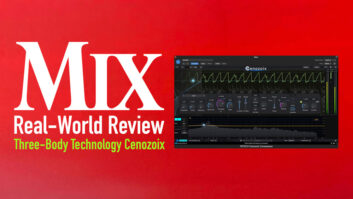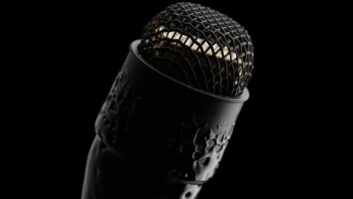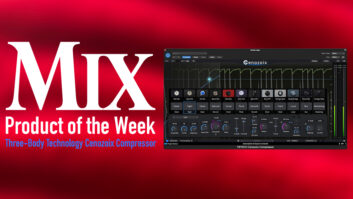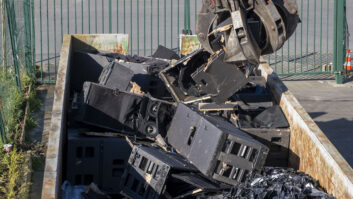The French are coming. Again. This summer the new Sensory II digital console took its maiden voyage to the New World, touring with Basque flamenco-pop ensemble Gipsy Kings. The console, as well as other sound services, were, for the second year, provided by Alan Hart’s Denver Audio.
The Sensory II system ($77,775 list) consists of a digital control surface, and a seven-rackspace Muxipaire modular digital audio frame and integral computer. The 6-foot-wide control surface weighs only 132 pounds and connects to the Muxipaire frame, which provides all the inputs and outputs normally associated with the back of an analog desk, at the FOH mix position. With the stage-box option ($17,500 list), the frame at FOH connects to another frame onstage via a single coaxial cable that handles up to 64 channels of digital audio. This setup not only allows the mic preamps to be placed near the source, but it also provides digitized audio signal splits for up to two more Sensory II mixers.
Having toured twice with the Gipsy Kings, I was curious to hear comments from their engineer for the past decade, Gilles Quentin, and from Denver Audio system tech Dave Wentling, formerly with the Everly Brothers. Quentin notes that the console is easy to use. “You just need to program your patch in and your patch out, then after you do your soundcheck, you just save your file,” he explains. “When you recall [your file], it’s the same; you only need to adjust your trim if the singers are a little louder or softer.”
Quentin admits that he was hesitant at first because of his previous experience with digital desks and cumbersome menus for accessing parameters. “With the Sensory, you simply select the channel with a button over the fader and you have everything on your screen for the channel all mapped to physical controls. It’s really easy.”
In addition to the usual features, such as 4-band parametric EQ, each of the 48 input channels has a full-featured gate and compressor. Because the frames are modular, various configurations are possible. At the top of the console are knobs for EQ, gate, compression and everything else associated with the selected channel, and a graphic representation of their settings appears on the monitor. “You see the knob turning on the screen as you make adjustments,” Wentling explains. The EQ section also shows the resulting curve on the monitor. “Another great thing is that you see the exact frequencies on the screen,” Wentling continues. “It’s not the usual guessing game with the silk-screen and the knob’s position as you’re spinning to find a frequency.”
“With this desk I don’t need the big rack for inserts,” Quentin comments. “Before, I had to choose where I would put my dynamics, but now if I want a gate or compression on any channel, it’s already there; I just turn it on.” Quentin and Wentling are using Version 5.8 software, which offers snapshot automation as well as options for semi-dynamic automation, allowing smooth theatrical crossfades and a fully automated version for working in timecode environments. Version 6.0 software will provide software-based gates, compression, delay and eight bands of EQ on all 20 outputs.
Wentling points out that the Sensory II offers a new way of mixing, “so it takes a little getting used to.” The mix is on moving faders that also serve as auxiliary sends. Selecting the aux bus mix by pressing a button over the aux master fader calls up that mix on the input faders. “You’d think that would take too much time while you’re mixing a show, but it really doesn’t,” explains Wentling. “It’s actually a little easier than trying to lean over while taking your finger and going down the line; this way you just select the output and watch the faders move to graphically show the auxiliary mix.”
Line-level effects are returned at the FOH frame and, as with all the mic inputs, they can be assigned to any channel. The internal soft-patch allows any channel to appear on any fader. As the system is digitally based, it offers functions not available on analog desks. Up to 40 sets of faders and channels can be grouped or linked. Channel settings are copied with a single keystroke, and, after making an EQ change, the engineer can choose to write it to only that scene or to “OverRAM,” which writes it to all scenes.
The stage-box option-a second seven-rackspace frame onstage and the one at the FOH mix position-can be connected with up to 1,500 feet of co-ax cable. The Sensory II desk is actually a remote control for the DigMix processor in the FOH rack. The software can be run from a laptop, which allows the operator to program the mixer offline. The Muxipaire was originally a 64-channel digital snake product introduced eight years ago. The addition of the DigMix module and the Sensory control surface turned it into a mixing system. Converters are 18-bit for the mic inputs and 16-bit for line inputs, with 40-bit floating point processing and less than 60 microseconds of latency. Several have been installed in broadcast studios and remote trucks in France, but the Gipsy Kings tour is the first live sound application.
However fast a mixer can reset, some aspects of a digital console require a period of adjustment. Each channel has a short name associated with it that appears on a four-digit LED display above the fader. “We still put a piece of board tape down, too, because we’re still getting used to it all,” Wentling says, “but the sound is there, and it’s definitely the shape of things to come.
“I was one of the first to say that I was worried about what it might sound like, but there’s no loss here, especially in a live situation” he continues. “With the Gypsies’ eight flamenco guitars, tons of vocals and a full band, this mixer seems to clarify things a little bit-maybe that’s because there’s a gate and compressor available on each channel, or because there’s less crosstalk than on an analog board.” In the beginning, Quentin was also afraid, but he has found it user-friendly. “I can easily control my mix,” he concludes. “Before, the sound was confused, because mixing the Gipsy Kings is difficult-not just bass, drums and keyboards, but there are many acoustic guitars and many vocals. My mix is clearer and instruments are more separate.”
At press time, the Gipsy Kings’ tour was completing a West Coast leg, with plans to continue on the East Coast in late August with a new EAW KF 750 rig. The next leg wraps with double-dates at the Tropicana, Wolf Trap and the BankBoston Pavilion in September. If you can’t catch a show, check out the mixer at the Pro Sound International (InnovaSON’s U.S. distributor) booth at AES in New York this month, or contact Pro Sound International, 305 River Rd., Tullytown, PA 19007; 215/949-3200; fax 215/949-8400; www.prosoundint.com.







